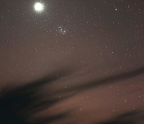The story of T Tauri

A CENTURY AGO, the universe seemed a static place. No one knew it was expanding. Indeed, Albert Einstein even temporarily added a fudge factor to his equations in order to keep his model of the cosmos stationary.
But surprisingly, even after recognising the universe’s expansion, astronomers failed to appreciate another fundamental feature of the cosmos. It’s something so commonsensical that both professional and amateur astronomers take it for granted today: The universe still produces new stars.
“At that time it was assumed that all stars were formed in some massive catastrophe in the early universe,” says Bo Reipurth (University of Hawai‘i). Thus, no stars form now.
Today we know our galaxy is actually a prolific star creator, spawning new stars in clouds of gas and dust such as the Orion Nebula. Each year the Milky Way converts about two solar masses of its gas and dust into new stars. Most are much less massive than the Sun, so this figure equates to the birth of about five new stars a year throughout our galaxy.
But the harbinger of the revolutionary revelation that the universe still makes new stars was hardly a spectacle. Instead, it was a dim star in Taurus named T Tauri, about
You’re reading a preview, subscribe to read more.
Start your free 30 days



